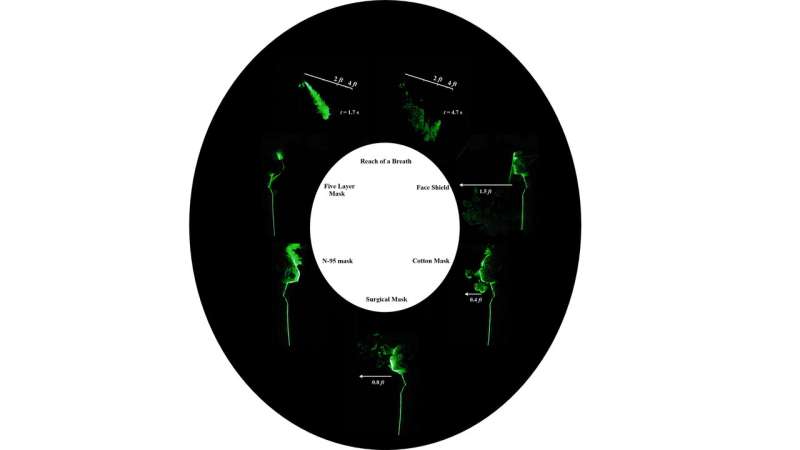Curbing coronavirus spread in enclosed spaces means better masks, adequate ventilation

With research increasingly showing the COVID-19 virus is transmissible via smaller droplets suspended in air, there is a growing concern current public health guidelines of mask wearing and social distancing are insufficient in combating its spread in indoor environments, like prisons, hospitals, and meatpacking plants, where people tend to be in close quarters.
Most research has focused on coughing and sneezing. But studies on how simply breathing might contribute to airborne spread of the virus are rare.
In AIP Advances, researchers at the Indian Institute of Technology Bhubaneswar show social distancing is equally important as mask wearing when people indoors are just breathing or participating in normal conversation, even when there is no risk of coughing or sneezing. They also found mask leakage in the same scenario presents a notable challenge in preventing the virus's spread.
"Our findings show the need for good ventilation systems that take into account the 5 to 10% of aerosolized particle leakage that occurs in each breathing cycle as a way to reduce droplet concentration in enclosed spaces," author Venugopal Arumuru said. "There also is a need for mask design innovation to reduce side and bottom droplet leakage while providing adequate face comfort."
In an experimental setup, a mechanical breathing simulator was connected to a mannequin standing at 5 feet 8 inches tall to simulate regular breath and slightly longer breath typical of healthy adults standing still or involved in moderate activity, like walking, talking, or participating in assembly work. The researchers evaluated the efficacy of various mask types, mask-shield combinations, and only face shield use.
A fog generator was filled with a mixture of water and glycerin to emulate the consistency of saliva droplets in the diameter range of 1-10 micrometers to reflect airborne transmissibility. Droplet exposure was illuminated and captured by video camera.
The researchers found that with no face covering, droplets from breathing can travel up to 4 feet in five seconds. A commercial five-layered mask was found to provide the best protection, with full front-of-face protection and minimal leakage below the chin. A commercial N-95 mask impedes droplet leakage in front, but leakage in gaps between the mask and nose was significant.
Leakage from the front of the surgical mask was evident, although adding a face shield increased droplet restriction.
"However, the noticeable droplets settling below the shield is concerning, and pairing surgical masks with shields is not adequate in hospitals and other places where strict social distancing guidelines are difficult to follow," Arumuru said.
More information: "Breathing, virus transmission and social distancing - An experimental visualization study" AIP Advances (2021). aip.scitation.org/doi/10.1063/5.0045582
Journal information: AIP Advances
Provided by American Institute of Physics





















